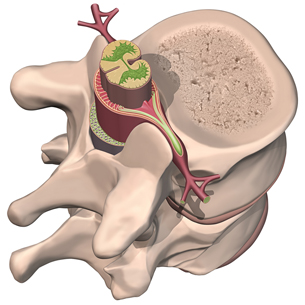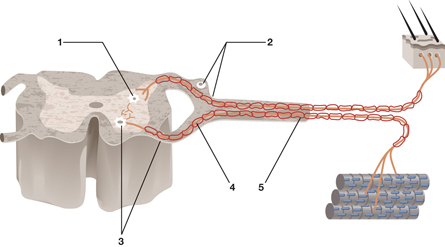Module 1
1. Module 1
1.10. Page 3
Module 1—The Nervous System
 Read
Read

© Stephen Sweet/shutterstock
You must know the structure of the spinal cord to understand how it performs its role in the nervous system. Read from the start of page 385 to the heading “The Brain” on page 386 in your textbook. Make brief summary notes or draw a graphical organizer. Store your notes or graphical organizer in your course folder.
The spinal cord is the major communication link between the brain and the peripheral nervous system (PNS). As you learned by reading the textbook and watching “The Peripheral Nervous System: Conscious vs. Unconscious Responses,” the spinal cord is protected by the backbone and cerebrospinal fluid. You will learn more about the role of cerebrospinal fluid later in this lesson.
The spinal cord is made up of two special types of nerves.
- Sensory nerves communicate messages from the body to the brain for interpretation.
- Motor nerves communicate messages from the brain to effectors that initiate a response.
In Lesson 3 you will learn more about these communication pathways, and you will discover another communication role of the spinal cord—the reflex arc.
 Self-Check
Self-Check
SC 3. Complete this drag-and-drop activity to test your knowledge of the parts of the spinal cord.
The Meninges and Cerebrospinal Fluid
 Try This
Try This
TR 1. The brain and spinal cord are essential to communication and keeping your body in balance. They must be protected. This activity reviews the roles of the skull, meninges, and cerebrospinal fluid and illustrates what happens when the brain gets “scrambled.”
Find two plastic containers that are a little bit larger than an egg. Make sure these containers have lids. Put an egg into each container. Fill one container with water. Firmly close each container with its lid. Shake the containers. Make your observations. Consider what parts of this demonstration illustrate the skull, the meninges, the cerebrospinal fluid, and the brain. What was the role of the water?
TR 2. Complete questions 2, 3, and 7 on page 395 of your textbook. You may wish to discuss your answers with your teacher or post your answers for discussion. Save your work in your course folder.
 Self-Check
Self-Check
These questions provide the opportunity to review and evaluate your understanding of the concepts in Lesson 2. Complete the questions, check your answers, and save your work in your course folder for reference when you study.
SC 4. The old adage “an elephant never forgets” appears to have some scientific basis. What area of the brain would you examine to begin researching this adage? Describe two technologies that might be useful in this research.
SC 5. Five situations in which you may find yourself are described below. Identify the part of the brain involved in processing each situation.
- You are on a boat. A sudden wind comes up, causing the boat to rock violently. You feel dizzy and nauseated, and you want to vomit.
- You are in a restaurant. The waiter brings you the bill. You reach into your pocket to retrieve your wallet.
- You are on a hike in the mountains when you suddenly come upon a grizzly sow with her two cubs. She rears up on her hind legs and growls menacingly. Your heart rate and breathing rate increase dramatically.
- You see a backpack.
- You hear a dog barking.
SC 6. Use the diagram of a neural pathway through the spinal cord to answer the questions that follow.

- Explain what would happen if only structure 2 were cut.
- Explain what would happen if only structure 4 were cut.
- Explain what would happen if structure 5 were cut.
 Self-Check Answers
Self-Check Answers
SC 4. The frontal lobe of the cerebrum appears to be where memory is created. In trying to investigate memory, MRI, PET, and CAT-scan technology may be used. Compare your description to the discussion on pages 392 to 394 of your textbook.
SC 5.
- cerebellum
- motor cortex of frontal lobe of cerebrum, or just cerebrum
- medulla oblongata and hypothalamus, or just medulla oblongata
- occipital lobe of cerebrum, or just occipital lobe
- temporal lobe of cerebrum, or just temporal lobe
SC 6.
- If only structure 2 (the dorsal root, which contains the sensory neurons) were cut, the person would not be able to sense stimuli but would be able to send nerve messages to the muscles.
- If only structure 4 (the ventral root, which contains the motor neurons) were cut, the person would not be able to send messages to the muscles—essentially paralyzing the muscles—but would be able to sense stimuli.
- If structure 5 (the spinal nerve, which contains both sensory and motor neurons) were cut, no sensory stimuli could be received from that area and no motor impulses could be sent to the muscles of that area.
 Discuss
Discuss
Are you right-handed or left-handed? Which hand do you write with? For most people, the hand that they use for most activities is an indication of the dominant hemisphere of their brain. Research the activities that are controlled by the right and left hemispheres of the brain and how information is communicated between the hemispheres. Search terms that you could use include “right hemisphere,” “left hemisphere,” and “dominance in the brain.”
 Module 1: Lesson 2 Assignment
Module 1: Lesson 2 Assignment
Retrieve the copy of the Module 1: Lesson 2 Assignment that you saved to your computer earlier in this lesson. In this part of your assignment, you will have the opportunity to discuss the role and characteristics of the dominant hemisphere of the brain. Complete Part 2—Discuss. Save your assignment in your course folder. You will receive instructions about when to submit your assignment to your teacher later in this lesson.